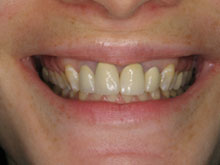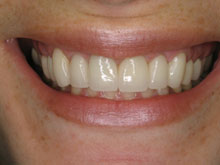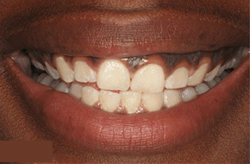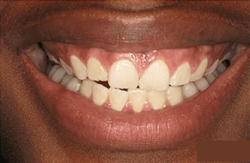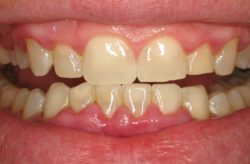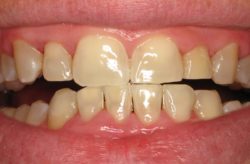Crown Lengthening
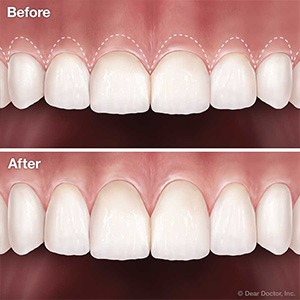
Crown lengthening is a procedure designed to reshape the gums at the base of the desired tooth or teeth. The purpose of this procedure is to expose additional tooth surface and, if necessary, adjust the bone level. There are many dental conditions that require crown lengthening as part of the restorative procedure. The most common condition requiring crown lengthening is severe tooth decay, where the decay extends below the gum line. Another common problem that calls for crown lengthening is when a tooth has fractured and broken off beneath the existing gum line. Crown lengthening often serves both the functions of cosmetics and necessity in cases where veneers, crowns or bridges are being placed. In these and other restorative procedures, crown lengthening may be vital to restoring a natural smile.
The Crown Lengthening Procedure
Crown lengthening is performed by your periodontist under a local anesthetic. (The local anesthetic can be combined with sedation for patients who desire it.) The selected area of the gums is reduced and contoured through the removal of small amounts of tissue. The goal is to lengthen the appropriate teeth and create optimal symmetry at the gum line.
The duration of the procedure will depend on the number of teeth that are compromised, the severity of the damage or decay, and if both soft tissue and bone need to be removed. During the routine dental examination, our specialists will examine the teeth for any signs of decay or damage.
The periodontist will make incisions that will allow the gums to be pulled away from the tooth’s surface, exposing the root and the bone. In most cases, just removing the gums is necessary to expose enough tooth to insert a filling or crown. Once enough tooth is exposed, the area will be sterilized with salt water and the gums will be sutured back into place.
In some advanced cases, it may be necessary to remove a bit of the bone as well. The gum tissue will be gently freed from both tooth and bone, and pulled back exposing the bone that supports the tooth. The height and width of bone surrounding the tooth will be reduced and contoured, and the gums repositioned and sutured.
Patients can return to their normal routines in a few days and complete healing may take one to two weeks. Our specialists will advise patients on the post surgical regimen, tailored to their particular situation. Patients will return for the several post-surgical visits, included in the total treatment plan.
When Is Crown Lengthening Necessary?
Crown lengthening is performed for several dental conditions that require this procedure. Common conditions include short teeth, severe tooth decay that is below the gumline, and a tooth that is fractured or broken below the gumline. When severe decay is present or a tooth is damaged, the tooth’s healthy area is reduced. This can affect the possibility of a successful restoration. Crown lengthening exposes more of the tooth’s surface, making it an anchor for future restorative work such as veneers, crowns, and more.
Recovery Process Following Crown Lengthening
The normal length of recovery for crown lengthening is about three months. However, while your gums are healing, you may continue normal activity. It is advised to avoid any strenuous activity for the first two days following the procedure. Physically demanding activities or heavy lifting can affect the healing process and cause more bleeding.
Following the procedure, it is essential to abide by the following guidelines provided by our specialists:
- Maintain a strict soft food diet. Do not eat any hard, brittle, spicy, sticky, or acidic foods. Also avoid chewing on the sutured side when eating.
- For the first 24 hours, avoid hot foods. Avoid consuming any hot foods and avoid the act of rinsing your mouth, as both can cause bleeding to last longer.
- Use an ice pack. To help reduce any swelling, place an ice pack over the affected area. Alternate the use of the ice pack every 20 minutes.
- Take the prescribed medication to alleviate any pain. Our specialists may prescribe certain medications to help reduce the pain. An antibiotic may also be prescribed to prevent any infection. Take the medications as instructed.
- Brush carefully. When brushing your teeth, gently brush the affected area. You may brush and floss normally in other areas.
- Avoid alcohol consumption. Avoid drinking alcohol until after the post-op appointment.
- Avoid smoking. Avoid smoking 7 to 10 days following the procedure.
Crown Lengthening to Restore Damaged Teeth
Crown lengthening can play a critical role in the restoration of damaged teeth. Severe tooth decay or injury may result in teeth broken or destroyed below the gum line. By exposing more of the tooth, the crown lengthening procedure provides a stable base for the final tooth restoration.
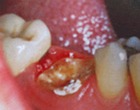
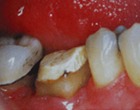
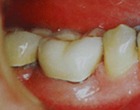
Cosmetic Application
Crown lengthening is also frequently used to support cosmetic dental procedures. It is especially useful in cases where the gum extends too far down the length of the teeth causing them to appear unnaturally short. This can also increase their vulnerability to periodontal disease. Removal of this “extra” gum tissue can restore a natural look and thus improve a smile.
